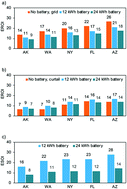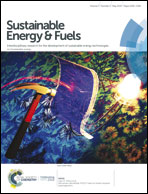The energetic implications of introducing lithium-ion batteries into distributed photovoltaic systems
Abstract
Batteries for stationary applications can prove to be crucial for enabling high penetration of solar energy, but production and use of batteries comes with an energetic cost. This study quantifies how adding a lithium-ion (Li-ion) battery affects the energetic performance of a typical residential photovoltaic (PV) system under a wide range of climatic conditions. If all generated power is either self-consumed or made available via an existing distribution grid, the PV system will have an energy return on investment (EROI) of between 14 (Alaska) and 27 (Arizona). While adding a 12 kW h Li-ion battery increases self-consumption considerably, this has a negative effect of decreasing the EROI by more than 20%. In a situation where all excess power generation is curtailed, the EROI can be as low as 7 (Alaska and Washington), although it can also be as high as 15 (Florida). Introducing a battery increases the EROI but it is still considerably lower than in cases where excess power generation is added to the grid. Doubling the battery size increases the average self-consumption marginally, but further decreases the EROI of the system because the extra energy invested to build the additional battery is used inefficiently. The results show that installing PV systems in locations with good solar resources and a grid that can accept excess production is desirable for maximizing the net energy return from distributed PV systems. Batteries have a benefit when excess electricity generation cannot be fed into the grid. Oversizing batteries has the effect of significantly reducing the EROI of the PV system.

- This article is part of the themed collection: 2019 Sustainable Energy and Fuels HOT Articles


 Please wait while we load your content...
Please wait while we load your content...